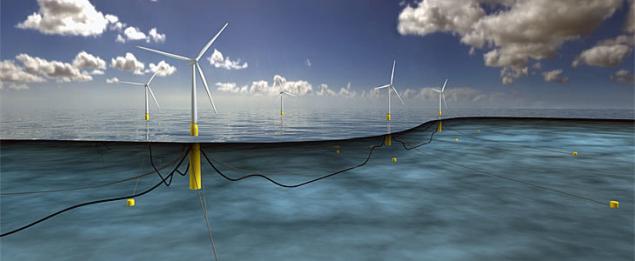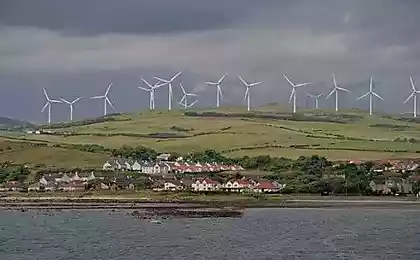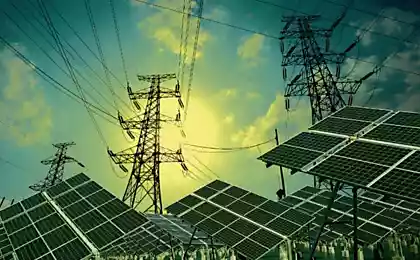524
Scotland Wind turbines generated 106% of the required electricity
The wind speed in the day reached 185 km / h

Ardrossan Wind Park in North Ayrshire, Scotland. Photo: Vincent van Zeijst
The last Sunday of August 7 Scotland set a record. For the first time in the history of wind power plants generated more electricity per day than it consumes the entire country. The ratio of energy generation to energy consumption amounted to 106%. As in Germany, the authorities in Scotland have to solve the problem of excess energy. One of the options - consumers pay for electricity consumption
. Environmental group WWF Scotland said that Scotland's wind turbines 7 August 2016 sent to the grid 39 545 MWh of electricity, while domestic consumption was 37 202 MWh.
WWF Scotland Experts admit that this happened sometime in the past, but since the start of monitoring the state of the power system in 2015, it is the first such case. "Given the commitment to complete the transition to renewable energy sources is an important milestone," - said the director of Banks Lang (Lang Banks)
. This achievement was made possible thanks to the fact that on 7 August was unusually windy day, and this is putting it mildly. The wind speed in the day reached 185 km / h in some regions of the country, leading to the closure of the bridge, the delay or cancellation of flights and trains.

Weather forecast from the UK Met Office August 7, 2016
Because of the wind in the fourth the size of the Scottish city of Dundee was partially off electricity, and oil drilling rig in the sea broke away from the tug and swam to the shore.
In spite of all these things, and the rampant disaster, representatives of the environmental movement say undoubted success: for the first time in the history of wind power plants generated more electricity per day than it consumes the entire country. However, for obvious reasons, on Sunday energy consumption was minimal: the plants do not work, the citizens hid from the wind, and some settlements have been de-energized. However, the "green" future on this day was real: Scotland could easily eliminate the use of oil, gas and coal
. It is interesting that Scotland owns approximately 60% (!) Of all the oil reserves in the European Union (they are mostly in the North Sea). Despite these vast oil reserves, the country is still promoting "green" energy. Particularly active this trend emerged in recent years as the cost of renewable electricity has fallen particularly low.
In April, the Department of Energy and Climate Change of Scotland announced the results of 2015. During the year from wind power plants 57, 7% of consumed electricity was obtained, so that the goal of complete the country's transition to renewable energy sources looks very real in 2030.
Scotland removes wind energy not only on land but also the sea. Last year, they built the world's largest floating wind power plant with five turbines 6 MW. The platform will be the anchors attached to the sea floor and the cable is connected to the shore. It will place about 25 km from the coast. Installing Hywind Scotland production of Norwegian company Statoil should produce approximately 135 GWh per year.

In the case of recurrence of such successful days for power on August 7, the government of Scotland hopes to export surplus energy resources in neighboring areas of England.
Scotland - not the only country that celebrates the successes in the development of clean energy. Germany some days receives up to 95% of electricity from renewable sources, and recently Portugal four days lived on solar energy.
It seems like a future without oil will come very soon. According to the forecast of analysts Bloomberg New Energy Finance (BNEF), fossil fuel consumption in the world will start to decline from the second 2025, and by 2027 the ninth year the construction of new solar and wind power will be cheaper than the content of the existing gas and coal.
Source: geektimes.ru/post/279412/

Ardrossan Wind Park in North Ayrshire, Scotland. Photo: Vincent van Zeijst
The last Sunday of August 7 Scotland set a record. For the first time in the history of wind power plants generated more electricity per day than it consumes the entire country. The ratio of energy generation to energy consumption amounted to 106%. As in Germany, the authorities in Scotland have to solve the problem of excess energy. One of the options - consumers pay for electricity consumption
. Environmental group WWF Scotland said that Scotland's wind turbines 7 August 2016 sent to the grid 39 545 MWh of electricity, while domestic consumption was 37 202 MWh.
WWF Scotland Experts admit that this happened sometime in the past, but since the start of monitoring the state of the power system in 2015, it is the first such case. "Given the commitment to complete the transition to renewable energy sources is an important milestone," - said the director of Banks Lang (Lang Banks)
. This achievement was made possible thanks to the fact that on 7 August was unusually windy day, and this is putting it mildly. The wind speed in the day reached 185 km / h in some regions of the country, leading to the closure of the bridge, the delay or cancellation of flights and trains.

Weather forecast from the UK Met Office August 7, 2016
Because of the wind in the fourth the size of the Scottish city of Dundee was partially off electricity, and oil drilling rig in the sea broke away from the tug and swam to the shore.
In spite of all these things, and the rampant disaster, representatives of the environmental movement say undoubted success: for the first time in the history of wind power plants generated more electricity per day than it consumes the entire country. However, for obvious reasons, on Sunday energy consumption was minimal: the plants do not work, the citizens hid from the wind, and some settlements have been de-energized. However, the "green" future on this day was real: Scotland could easily eliminate the use of oil, gas and coal
. It is interesting that Scotland owns approximately 60% (!) Of all the oil reserves in the European Union (they are mostly in the North Sea). Despite these vast oil reserves, the country is still promoting "green" energy. Particularly active this trend emerged in recent years as the cost of renewable electricity has fallen particularly low.
In April, the Department of Energy and Climate Change of Scotland announced the results of 2015. During the year from wind power plants 57, 7% of consumed electricity was obtained, so that the goal of complete the country's transition to renewable energy sources looks very real in 2030.
Scotland removes wind energy not only on land but also the sea. Last year, they built the world's largest floating wind power plant with five turbines 6 MW. The platform will be the anchors attached to the sea floor and the cable is connected to the shore. It will place about 25 km from the coast. Installing Hywind Scotland production of Norwegian company Statoil should produce approximately 135 GWh per year.

In the case of recurrence of such successful days for power on August 7, the government of Scotland hopes to export surplus energy resources in neighboring areas of England.
Scotland - not the only country that celebrates the successes in the development of clean energy. Germany some days receives up to 95% of electricity from renewable sources, and recently Portugal four days lived on solar energy.
It seems like a future without oil will come very soon. According to the forecast of analysts Bloomberg New Energy Finance (BNEF), fossil fuel consumption in the world will start to decline from the second 2025, and by 2027 the ninth year the construction of new solar and wind power will be cheaper than the content of the existing gas and coal.
Source: geektimes.ru/post/279412/
I never cooked cabbage rolls for this recipe: awesome dish for all occasions.
As prayer changes the blood





















